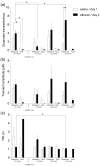Effects of age and acute ethanol on glutamatergic neurotransmission in the medial prefrontal cortex of freely moving rats using enzyme-based microelectrode amperometry
- PMID: 25927237
- PMCID: PMC4416039
- DOI: 10.1371/journal.pone.0125567
Effects of age and acute ethanol on glutamatergic neurotransmission in the medial prefrontal cortex of freely moving rats using enzyme-based microelectrode amperometry
Abstract
Ethanol abuse during adolescence may significantly alter development of the prefrontal cortex which continues to undergo structural remodeling into adulthood. Glutamatergic neurotransmission plays an important role during these brain maturation processes and is modulated by ethanol. In this study, we investigated glutamate dynamics in the medial prefrontal cortex of freely moving rats, using enzyme-based microelectrode amperometry. We analyzed the effects of an intraperitoneal ethanol injection (1 g/kg) on cortical glutamate levels in adolescent and adult rats. Notably, basal glutamate levels decreased with age and these levels were found to be significantly different between postnatal day (PND) 28-38 vs PND 44-55 (p<0.05) and PND 28-38 vs adult animals (p<0.001). We also observed spontaneous glutamate release (transients) throughout the recordings. The frequency of transients (per hour) was significantly higher in adolescent rats (PND 28-38 and PND 44-55) compared to those of adults. In adolescent rats, post-ethanol injection, the frequency of glutamate transients decreased within the first hour (p<0.05), it recovered slowly and in the third hour there was a significant rebound increase of the frequency (p<0.05). Our data demonstrate age-dependent differences in extracellular glutamate levels in the medial prefrontal cortex and suggest that acute ethanol injections have both inhibitory and excitatory effects in adolescent rats. These effects of ethanol on the prefrontal cortex may disturb its maturation and possibly limiting individuals´ control over addictive behaviors.
Conflict of interest statement
Figures







Similar articles
-
Tonic and phasic release of glutamate and acetylcholine neurotransmission in sub-regions of the rat prefrontal cortex using enzyme-based microelectrode arrays.J Neurosci Methods. 2011 Nov 15;202(2):199-208. doi: 10.1016/j.jneumeth.2011.08.020. Epub 2011 Aug 27. J Neurosci Methods. 2011. PMID: 21896284 Free PMC article.
-
Selective potentiation of (α4)3(β2)2 nicotinic acetylcholine receptors augments amplitudes of prefrontal acetylcholine- and nicotine-evoked glutamatergic transients in rats.Biochem Pharmacol. 2013 Nov 15;86(10):1487-96. doi: 10.1016/j.bcp.2013.09.005. Epub 2013 Sep 16. Biochem Pharmacol. 2013. PMID: 24051136 Free PMC article.
-
Nociceptin/orphanin FQ decreases glutamate transmission and blocks ethanol-induced effects in the central amygdala of naive and ethanol-dependent rats.Neuropsychopharmacology. 2014 Apr;39(5):1081-92. doi: 10.1038/npp.2013.308. Epub 2013 Oct 30. Neuropsychopharmacology. 2014. PMID: 24169802 Free PMC article.
-
Adjunctive treatment with asenapine augments the escitalopram-induced effects on monoaminergic outflow and glutamatergic neurotransmission in the medial prefrontal cortex of the rat.Int J Neuropsychopharmacol. 2014 Oct 31;18(3):pyu068. doi: 10.1093/ijnp/pyu068. Int J Neuropsychopharmacol. 2014. PMID: 25522408 Free PMC article.
-
Effects of repeated cocaine on medial prefrontal cortical GABAB receptor modulation of neurotransmission in the mesocorticolimbic dopamine system.J Neurochem. 2004 Aug;90(4):839-47. doi: 10.1111/j.1471-4159.2004.02525.x. J Neurochem. 2004. PMID: 15287889
Cited by
-
Disrupting Glutamate Co-transmission Does Not Affect Acquisition of Conditioned Behavior Reinforced by Dopamine Neuron Activation.Cell Rep. 2017 Mar 14;18(11):2584-2591. doi: 10.1016/j.celrep.2017.02.062. Cell Rep. 2017. PMID: 28297663 Free PMC article.
-
Role of glutamatergic system and mesocorticolimbic circuits in alcohol dependence.Prog Neurobiol. 2018 Dec;171:32-49. doi: 10.1016/j.pneurobio.2018.10.001. Epub 2018 Oct 11. Prog Neurobiol. 2018. PMID: 30316901 Free PMC article. Review.
-
Astrocytes modulate extracellular neurotransmitter levels and excitatory neurotransmission in dorsolateral striatum via dopamine D2 receptor signaling.Neuropsychopharmacology. 2022 Jul;47(8):1493-1502. doi: 10.1038/s41386-021-01232-x. Epub 2021 Nov 22. Neuropsychopharmacology. 2022. PMID: 34811469 Free PMC article.
-
Amperometric Self-Referencing Ceramic Based Microelectrode Arrays for D-Serine Detection.Biosensors (Basel). 2018 Mar 6;8(1):20. doi: 10.3390/bios8010020. Biosensors (Basel). 2018. PMID: 29509674 Free PMC article.
-
Midbrain Gene Screening Identifies a New Mesoaccumbal Glutamatergic Pathway and a Marker for Dopamine Cells Neuroprotected in Parkinson's Disease.Sci Rep. 2016 Oct 20;6:35203. doi: 10.1038/srep35203. Sci Rep. 2016. PMID: 27762319 Free PMC article.
References
-
- deGraaf-Peters VB, Hadders-Algra M. Ontogeny of the human central nervous system: what is happening when? Early human development 2006;82: 257–266. - PubMed
-
- Spear LP. The adolescent brain and age-related behavioral manifestations. Neuroscience and biobehavioral reviews. 2000;24: 417–63. - PubMed
-
- Blakemore SJ, Choudhury S. Development of the adolescent brain: implications for executive function and social cognition. Journal of child psychology and psychiatry, and allied disciplines. 2006;47: 296–312. - PubMed
-
- Maletic-Savatic M, Malinow R, Svoboda K. Rapid dendritic morphogenesis in CA1 hippocampal dendrites induced by synaptic activity. Science. 1999;283: 1923–7. - PubMed
-
- Toni N, Buchs PA, Nikonenko I, Bron CR, Muller D. LTP promotes formation of multiple spine synapses between a single axon terminal and a dendrite. Nature. 1999; 402:421–5. - PubMed
Publication types
MeSH terms
Substances
LinkOut - more resources
Full Text Sources
Other Literature Sources

